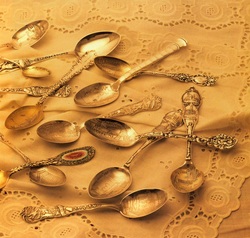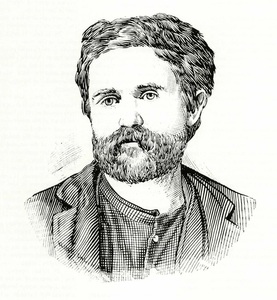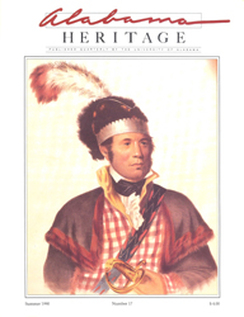|
On the cover: Chief William McIntosh painted by Charles Bird King, c. 1825. (From McKenney and Hall, History of the Indian Tribes, vol. I, 1836)
Although this issue is no longer in print, scroll down to find some features from this issue that are available for purchase as downloadable PDFs.
|
FEATURE ABSTRACTS
Chief William McIntosh
Scottish-Indian Statesman and General
By Benjamin W. Griffith, Jr.
William McIntosh was born around 1778, the son of a Savannah Tory and a full-blooded Creek woman. Over the course of his life, McIntosh gained fame as a diplomat and a warrior, but increasingly he became caught in crosscurrents between the white and Indian worlds. His genius for American entrepreneurship made him a prominent figure in both worlds, precisely the exalted position from which tragic heroes fall. This is his story.
Additional Information
About the Author
Benjamin W. Griffith, Jr., emeritus professor of English and dean of the Graduate School, West Georgia College, was formerly Pollock Professor of English and chairman of the department, 1955-70, at Mercer University. The author of
more than sixty articles on American and English literature, Griffith has also published ten textbooks used in English courses, including works on the writings of John Dryden, John Gay, Mark Twain, Emily Bronte, and George Elliot; three books on grammar and writing; and a dictionary of literary and grammatical terms.
His most recent book, Mcintosh and Weatherford, Creek Indian Leaders, is a study of Indian-white relations on the frontier in the period from the Revolutionary War to the Indians' removal to the West in the 1830s. It is available from The University of Alabama Press, P.O. Box 870380, Tuscaloosa, Alabama 35487-0380.
Scottish-Indian Statesman and General
By Benjamin W. Griffith, Jr.
William McIntosh was born around 1778, the son of a Savannah Tory and a full-blooded Creek woman. Over the course of his life, McIntosh gained fame as a diplomat and a warrior, but increasingly he became caught in crosscurrents between the white and Indian worlds. His genius for American entrepreneurship made him a prominent figure in both worlds, precisely the exalted position from which tragic heroes fall. This is his story.
Additional Information
- Green, Michael D. The Politics of Indian Removal: Creek Government and Society in Crisis (University of Nebraska Press, 1982).
- Griffith, Benjamin W., Jr. Mcintosh and Weatherford, Creek Indian Leaders (University of Alabama Press, 1988).
- Hudson, Charles M. The Southeastern Indians (University of Tennessee Press, 1976).
- Halbert, H. S., and T. H. Ball. The Creek War of 1813 and 1814 (1895). Reprint edited by Frank L. Owsley, Jr. (University of Alabama Press, 1969).
- Owsley, Frank L., Jr. Struggle for the Gulf Borderlands: The Creek War and the Battle of New Orleans, 1812-1815 (University of Aorida Press, 1981).
About the Author
Benjamin W. Griffith, Jr., emeritus professor of English and dean of the Graduate School, West Georgia College, was formerly Pollock Professor of English and chairman of the department, 1955-70, at Mercer University. The author of
more than sixty articles on American and English literature, Griffith has also published ten textbooks used in English courses, including works on the writings of John Dryden, John Gay, Mark Twain, Emily Bronte, and George Elliot; three books on grammar and writing; and a dictionary of literary and grammatical terms.
His most recent book, Mcintosh and Weatherford, Creek Indian Leaders, is a study of Indian-white relations on the frontier in the period from the Revolutionary War to the Indians' removal to the West in the 1830s. It is available from The University of Alabama Press, P.O. Box 870380, Tuscaloosa, Alabama 35487-0380.
 Birmingham spoons depicting ore mines, furnaces, Vulcan, City Hall, and various other buildings and scenes of importance to Birmingham residents at the tum of the century.
Birmingham spoons depicting ore mines, furnaces, Vulcan, City Hall, and various other buildings and scenes of importance to Birmingham residents at the tum of the century.
Souvenir Spoons from Alabama
By Nancy Rohr
In 1891 a new fad swept the nation: spoons. With the Gilded Age firmly underway, more Americans than ever were traveling, and these tourists wanted souvenirs to take home with them. Spoons, inexpensive and portable, engraved with the name of the city and featuring some ornamental design, were a popular option. Still recovering from the Civil War, Alabama had few tourist sites during this period, and so produced relatively few spoons. And yet, these souvenirs of Alabama do exist--spread across the United States by visitors, hidden in tiny shops and antique stores throughout the country. This article examines the history of the collectible spoon.
By Nancy Rohr
In 1891 a new fad swept the nation: spoons. With the Gilded Age firmly underway, more Americans than ever were traveling, and these tourists wanted souvenirs to take home with them. Spoons, inexpensive and portable, engraved with the name of the city and featuring some ornamental design, were a popular option. Still recovering from the Civil War, Alabama had few tourist sites during this period, and so produced relatively few spoons. And yet, these souvenirs of Alabama do exist--spread across the United States by visitors, hidden in tiny shops and antique stores throughout the country. This article examines the history of the collectible spoon.
Additional Information
About the Author
Nancy Rohr, a native of West Virginia and a former school teacher, has lived in Huntsville since 1968. She became
interested in spoon collecting some twenty years ago when her mother gave her several spoons that had been in the
family for years. "I was fascinated by the history they represented," she says. "So many of the buildings depicted in these spoons have been torn down. In some cases, all we have left of these structures are their engravings in spoons." Rohr's collection now includes a wide variety of spoons-children's spoons, medicine spoons, English spoons, American coin spoons, and one of her favorites, Alabama spoons. "These are particularly exciting to find," she says, ''because so few of them were made." According to Rohr, collectors may share their delight with other "spooners" by joining the American Spoon Collectors Society in care of Bill Boyd, 4922 State Line Street, Westwood Hills, Kansas 66205.
- Hardt, Anton. Adventuring Further in Souvenir Spoons (privately printed, 1965).
- _____. Souvenir Spoons of the 90's (privately printed, 1962).
- James, George B., Jr. Souvenir Spoons (A. W. Guller & Co., 1981).
- Rainwater, Dorothy T., and Donna H. Felger. American Spoons, Souvenir and Historical (Thomas Nelson & Sons and Everybodys Press, 1968).
- Stutzenberger, Albert. The American Story in Spoons (privately printed, 1953).
About the Author
Nancy Rohr, a native of West Virginia and a former school teacher, has lived in Huntsville since 1968. She became
interested in spoon collecting some twenty years ago when her mother gave her several spoons that had been in the
family for years. "I was fascinated by the history they represented," she says. "So many of the buildings depicted in these spoons have been torn down. In some cases, all we have left of these structures are their engravings in spoons." Rohr's collection now includes a wide variety of spoons-children's spoons, medicine spoons, English spoons, American coin spoons, and one of her favorites, Alabama spoons. "These are particularly exciting to find," she says, ''because so few of them were made." According to Rohr, collectors may share their delight with other "spooners" by joining the American Spoon Collectors Society in care of Bill Boyd, 4922 State Line Street, Westwood Hills, Kansas 66205.
 The train robber Rube Burrow (1854-1890) was Alabama's most notorious outlaw and one of the South's most wanted men until he was shot dead on
the streets of Linden, Alabama. (Engraving from "Rube Burrow, King of the Outlaws, and His Band of Train Robbers," by G. W. Agee.)
The train robber Rube Burrow (1854-1890) was Alabama's most notorious outlaw and one of the South's most wanted men until he was shot dead on
the streets of Linden, Alabama. (Engraving from "Rube Burrow, King of the Outlaws, and His Band of Train Robbers," by G. W. Agee.)
Rube Burrow, Outlaw
By William Warren Rogers, Jr.
The train robber Rube Burrow (1854-1890) was Alabama's most notorious outlaw and one of the South's most wanted men until he was shot dead on the streets of Linden, Alabama. His is a story of pistols and Pinkertons, of violence and vengeance. His career was steeped in blood, and his death--in an unexpected place and from an unexpected quarter--was covered in irony. This is his story, the tale of an outlaw who never repented and of the bullet he never saw coming.
By William Warren Rogers, Jr.
The train robber Rube Burrow (1854-1890) was Alabama's most notorious outlaw and one of the South's most wanted men until he was shot dead on the streets of Linden, Alabama. His is a story of pistols and Pinkertons, of violence and vengeance. His career was steeped in blood, and his death--in an unexpected place and from an unexpected quarter--was covered in irony. This is his story, the tale of an outlaw who never repented and of the bullet he never saw coming.
Additional Information
About the Author
Warren Rogers, a native Alabamian, is an instructor in history at the University of Alabama. He earned his bachelor's degree at Florida State University and his master's and doctorate in history at Auburn University. While a student at Auburn, Rogers became interested in Rube Burrow and developed the subject into his master's thesis; he is currently expanding his thesis into a full-length book.
- Acee, Joe. You Are There with the True Adventures of Rube Burrow, Alabama's Most Famous Train Robber (Lamar Democrat, 1973).
- Chappell, Gordon T. " 'Gentleman Jim': Montgomery's Notorious Robber," The Alabama Review 24 (1971): 3-16.
- Hoole, William Stanley. The James Boys Rode South (privately printed, 1955).
- _____. The Saga of Rube Burrow: King of American Train Robbers and His Band of Outlaws (Confederate Publishing, 1981).
- Rogers, William Warren, Jr. "Journalistic Warfare: The Atlanta Constitution, the Birmingham Age-Herald and the Burrow
- Interview," Alabama Historical Quarterly 43 (Spring 1981): 34-41.
- ____. "Violence and Outlawry in the New South: Rube Burrow's Train Robbing Days in Alabama, Mississippi, and Florida," (Master's thesis: Auburn University, 1979).
- Rogers, William Warren, Sr., and Ruth Pruitt. Stephen S. Renfroe: Alabama's Outlaw Sheriff (Sentry Press, 1972).
- Wright, A. J. Criminal Activity in the Deep South 1700-1930: An Annotated Bibliography (Greenwood Press, 1989).
- Agee, George W. Rube Burrow,King of Outlaws and His Band of Train Robbers; An Accurate and Faithful History of Their Exploits and Adventures (M. A. Donohue, 1890).
- Hawkeye, Harry [Paul Emilius Lowe]. Rube Burrow the Outlaw; A Book of Thrilling Adventure and Desperate Deeds, Narrating Actual Facts as Obtained from Principals and Eyewitnesses (I & M Ottenheimer, 1908).
- Monley, Marlin. Rube Burrow; or Life, Exploits, and Death of the Bold Train Robber (Street & Smith, 1898).
- Ray, Clarence E., ed. The Alabama Wolf, Rube Burrow, and His Desperate Gang of Highwaymen, Wild West Series, no. 7 (Regan Publishing Corp., c. 1920).
- Stout, F. E. Rube Burrow; or, Life, Exploits and Death of the Bold Train Robber (n.p., 1890).
- Ward, William. Rube Burrow of Sunny Alabama; The True Story of the Prince of Train Robbers to Capture Whom the Southern Express Company Spent $20,000, and Kept an Army of Detectives in Three States for Four Years; As Told by One of the Detectives and Written out by William Ward, Adventure Series, no. 8 (Arthur Westbrook Company, c. 1906).
About the Author
Warren Rogers, a native Alabamian, is an instructor in history at the University of Alabama. He earned his bachelor's degree at Florida State University and his master's and doctorate in history at Auburn University. While a student at Auburn, Rogers became interested in Rube Burrow and developed the subject into his master's thesis; he is currently expanding his thesis into a full-length book.
